Calvin Hill
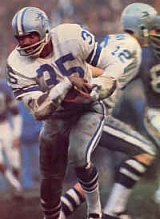
Calvin Hill
With the NFL season starting this week we recognize as the Sports Then and Now Vintage Athlete of the Week a player who was the NFL Rookie of the Year 40 years ago and went on to a successful 12-year career.
Many were surprised when the Dallas Cowboys used the 24th pick in the 1969 draft to select a running back from Yale University. However, Calvin Hill proved to be a perfect pick.
Dallas coaches originally thought the 6-foot-4 inch, 227 pound Hill might be better suited for the NFL as a tight end, but the retirement of running back Don Perkins and injuries to other backs at the start of the 1969 training camp forced the Cowboys to keep Hill in the backfield.
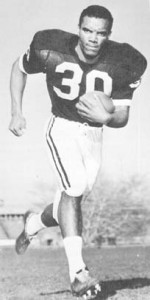
Though he played his college football at Yale, which wasn't known for producing NFL stars, Calvin Hill was drafted in the first round of the 1969 NFL Draft by the Dallas Cowboys.
As it turned out, it was one of the best non-moves that Hall of Fame coach Tom Landry ever made.
Hill rushed for 70 yards and threw a 53-yard touchdown pass in his first NFL game as Dallas defeated the St. Louis Cardinals 24-3. The next week, Hill rushed for 138 yards and two touchdowns in a 21-17 victory over New Orleans.
Through the first nine games of the season, Hill was the best running back in football with 807 yards rushing and seemed on his way to easily breaking the NFL rookie rushing record of 1,004 yards set by Beattie Feathers of the Chicago Bears in 1934.
However, while rushing for 150 yards in a 41-28 victory over the Washington Redskins in the ninth game of the season, Hill suffered a broken bone in his foot.
He missed the next game and then gained only 135 yards over the final four games as Gale Sayers passed him for the NFL rushing lead and Hill finished with 942 yards to fall short of the rookie record.
For the next two seasons, Hill played well when in the lineup, but injuries and the presence of Duane Thomas, who Dallas drafted in the first round of the 1970 draft, limited his opportunities.
Dallas advanced to the Super Bowl in each season, but Hill had only one kickoff return in a 16-13 loss in Super Bowl V and the following season had 25 yards rushing as the Cowboys defeated the Dolphins 24-3.
Finally, in 1972 Hill was able to overcome his history of injuries and reemerge as one of the top rushers in the league.
He became the first running back in Dallas Cowboys history to crack the 1,000-yard mark and finished seventh in the NFL with 1,036 yards rushing. Hill also displayed his talent as a pass catcher as he ranked in the top 10 in the conference with 43 receptions. His 1,400 total yards from scrimmage ranked fourth in the NFL.
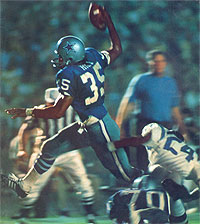
Calvin Hill was the first running back in Dallas Cowboys history to rush for more than 1,000 yards in a season.
The following season, Hill was even better with 1,142 yards rushing to finish third in the NFL and only two yards behind John Brockington in the NFC. His 1,432 yards from scrimmage were second in the NFL.
Hill and the Cowboys appeared headed for their third Super Bowl in four years before injuries again raised their ugly head.
In the opening round of the NFC Playoffs against the Los Angeles Rams, Hill rushed for 97 yards, but suffered a separated shoulder in the second half diving for a loose ball after a fumble.
The Cowboys won the game 27-16, but without Hill in the lineup were unable to overcome the Minnesota Vikings the following week in the NFC Championship Game.
Injuries continued to haunt Hill in 1974 as he played in only 12 games as Dallas missed the playoffs for the first time in his career. However, Hill still ranked eighth in the NFL with 844 yards rushing and was selected to the Pro Bowl for the fourth time in six seasons with the Cowboys.
Playing in an era when player salaries were tightly controlled and free agency was non-existent, Hill joined several other NFL stars (including Miami Dolphins stars Paul Warfield, Jim Kiick and Larry Csonka) following the 1974 season to bolt the NFL for the new World Football League (WFL).
Hill joined The Hawaiian, based in Honolulu and was immediately the biggest name on the roster. He played in three games before suffering a torn medial collateral ligament in his right knee.
The injury ended Hill’s brief foray into the WFL and effectively ended his time as a featured running back.
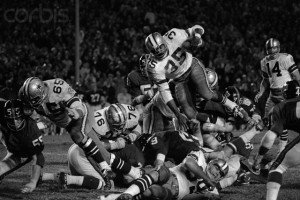
Hill was known for his style of jumping over blockers and defenders.
After the WFL folded following the 1975 season, Hill was declared a free agent and signed with the Cowboys’ archrivals the Washington Redskins.
In two seasons with Washington, Hill was only a shell of the player that had terrorized the Skins during his six seasons with the Cowboys.
Instead, Hill rushed for only 558 yards and caught 25 passes in 28 games.
It appeared that his career might be over following the 1977 season as veteran coach George Allen left the Skins and new head coach Jack Pardee looked to make the team younger.
Hill was out of the league at the start of the season, but after four games signed with the Cleveland Browns, who were looking for a veteran running back to compliment perennial All-Pro tailback Greg Pruitt and emerging fullback Mike Pruitt.
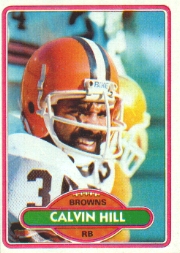
Hill spent four seasons with the Cleveland Browns and was used primarily as a receiver out of the backfield.
Though he rushed the ball 80 times in his first season with the Browns due to injuries to Greg Pruitt, Hill’s primary role was as a receiver out of the backfield.
In his first three seasons with the Browns, Hill caught 90 passes for 1,098 yards and 14 touchdowns. He also brought veteran leadership and experience to a team that was on the rise.
The Browns just missed the playoffs in 1978 and 1979 and in 1980 posted an 11-5 record and won the AFC Central Division title for the first time since 1971.
Hill retired following the 1981 season with career totals of 6,083 yards rushing, 271 receptions, 8,944 yards from scrimmage and 65 touchdowns. At the time of his retirement, Hill was the 16th leading rusher in NFL history (he now ranks 67th).
Following his retirement, Hill worked in the front office for the Cleveland Browns and Baltimore Orioles. He now is with the Dallas Cowboys.
Over the last two decades, Hill has received notoriety as part of one of the best father-son athletic tandems in sports history. His son, Grant, was an All-American basketball player at Duke University and has been an All-Star in the NBA playing for the Detroit Pistons, Orlando Magic and Phoenix Suns.
If you had a favorite athlete growing up that you would like to see featured as the Sports Then and Now Vintage Athlete of the Week, send me a nomination by e-mail.









